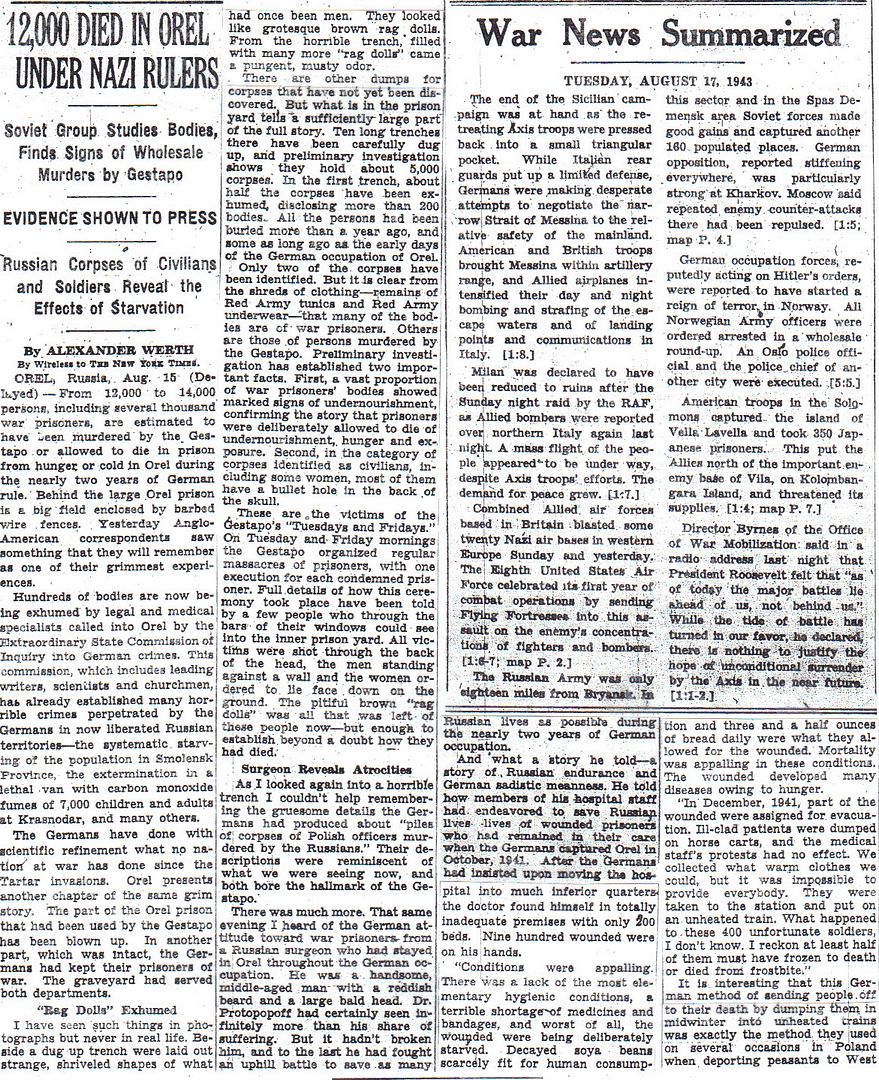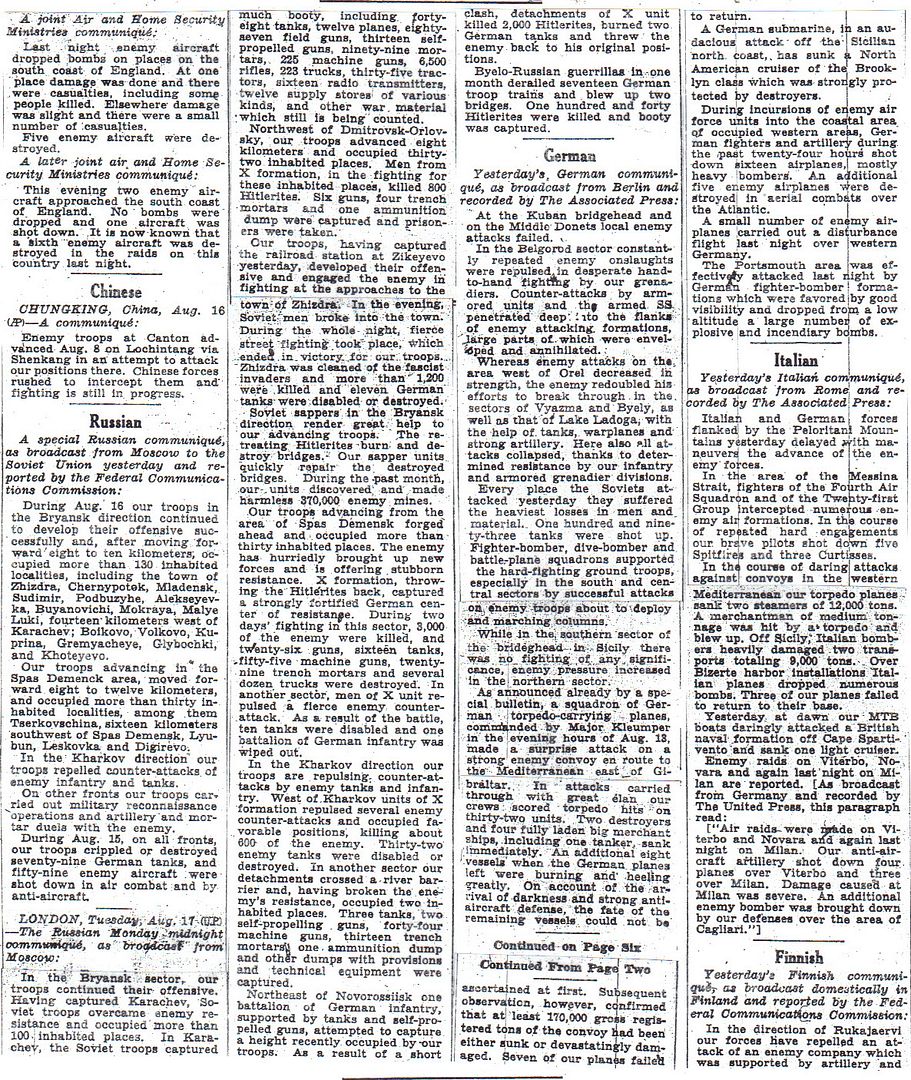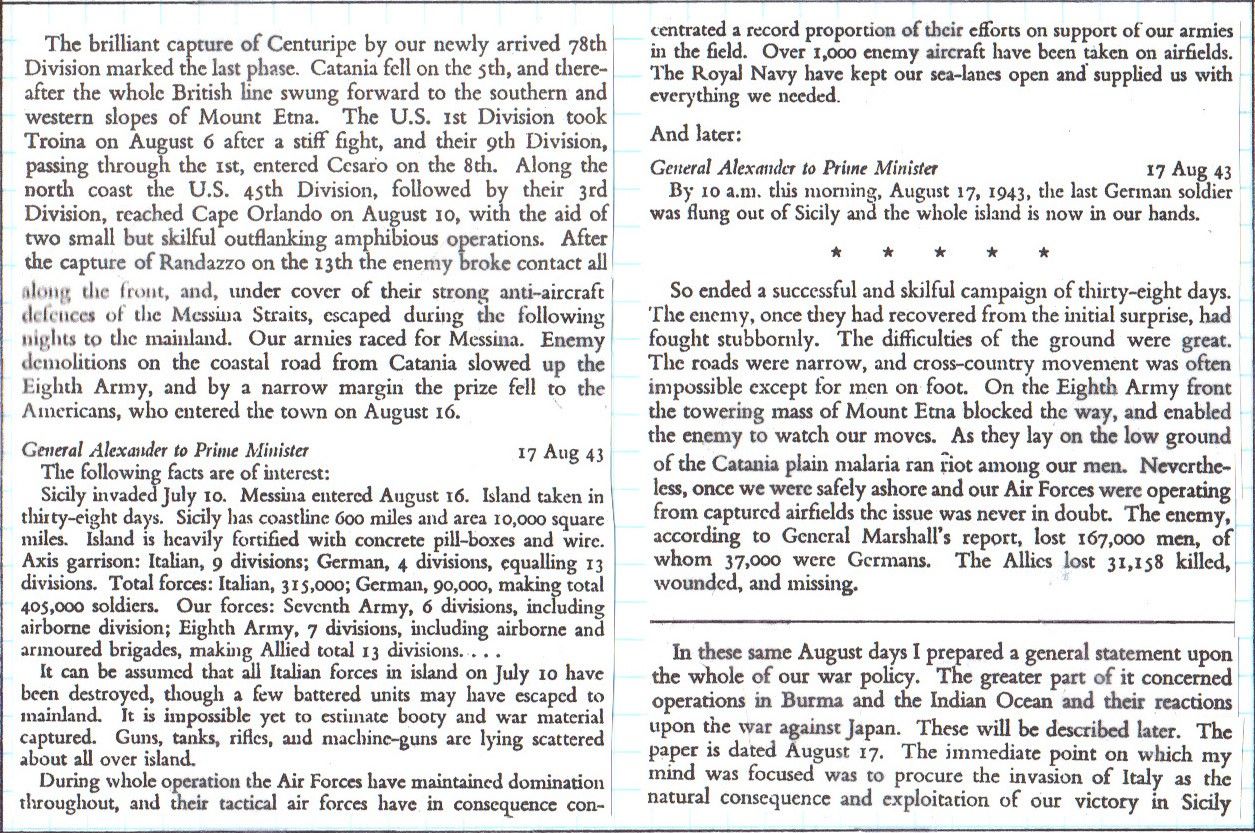
Posted on 08/17/2013 6:01:29 AM PDT by Homer_J_Simpson
















Winston S. Churchill, Closing the Ring
* Colonel Fred M. Dean, the 26-year-old Group Commander of the first United States Army Air Forces fighter group to operate from a captured Sicilian base . . .
Seems awfully young for a colonel.
http://www.onwar.com/chrono/1943/aug1943/f17aug43.htm
American bomber raid ball-bearing plants
Tuesday, August 17, 1943 www.onwar.com
Results of the bombing of Schweinfurt [photo at link]
Over Germany... The USAAF bombs the ball-bearing manufacturing centers at Schweinfurt and Regensburg in a daylight raid. A total of 51 bombers are lost. During the night (August 17-18), the German rocket research center at Peenemunde is bombed by nearly 600 British bombers. A total of 41 bombers are lost in the raid. This bombing creates a significant delay in the German rocket program. Also noteworthy about the raid is the British use of “window,” dropped by Mosquito bombers, which causes about 200 German fighters to concentrate over Berlin.
In the Solomon Islands... A small number of Japanese reinforcements land on Vella Lavella. There is an inconclusive battle between American destroyers and the Japanese transport force.
In Sicily... General Patton’s troops arrive in Messina a few hours before British troops. The camapaign in Sicily is concluded. About 40,000 German troops with 50 tanks and 100 guns plus a large quantity of supplies and 62,000 Italian troops have been evacuated from the island to Italy, across the Messina Strait. About 10,000 Germans have been killed or captured. More than 100,000 Italians have been taken prisoner. Allied forces has suffer 7000 killed and 15,000 wounded.
http://www.etherit.co.uk/month/thismonth/17.htm
August 17th, 1943 (TUESDAY)
UNITED KINGDOM:
During the night of 17/18 August, the RAF begins Operation CROSSBOW, massive attacks on German V-weapon sites. The aircraft drop 2,000 tons of bombs on Peenemunde, Germany.
596 aircraft - 324 Lancasters, 218 Halifaxes, 54 Stirlings were dispatched to bomb Peenemünde.
This was a special raid which Bomber Command was ordered to carry out against the German research establishment on the Baltic coast where V2 rockets were being built and tested. The raid was carried out in moonlight to increase the chances of success. There were several novel features:- there was a Master Bomber controlling a full-scale Bomber Command raid for the first time; There were three aiming points - the scientists’ and workers’ living quarters, the rocket factory and the experimental station; The Pathfinders employed a special plan with crews designated as ‘shifters,’ who attempted to move the marking from one part of the target to another as the raid progressed; Crews of No 5 Group; bombing in the last wave of the attack, had practised the ‘time-and-distance’ bombing method as an alternative method for their part in the raid.
The Pathfinders found Peenemünde without difficulty in the moonlight and the Master Bomber controlled the raid successfully throughout. A Mosquito diversion to Berlin drew off most of the German night-fighters for the first two of the raid’s three phases. The estimate has appeared in many sources that this raid set back the V-2 experimental programme by at least two months and reduced the scale of the eventual rocket attack.
Bomber Command’s losses were 40 aircraft - 23 Lancasters, 15 Halifaxes and 2 Stirlings. This represents 6.7 per cent of the force dispatched but was judged an acceptable cost for the successful attack on this important target on a moonlit night. Most of the casualties were suffered by the aircraft of the last wave when the German night fighters arrived in force. This was the first night on which the Germans used their new schräge Musik weapons; these were twin upward-firing cannons fitted in the cockpit of Me 110s. Two schräge Musik aircraft found the bomber stream flying home from Peenemünde and are believed to have shot down six of the bombers lost on the raid.
The US 8th Airforce mounts today’s strike at Schweinfurt and Regensburg. The targets are the ball-bearing plants. 51 bombers are lost, which is deemed an unacceptable loss rate.
Tonight the RAF will target Peenemunde. This is the center of German rocket research and manufacturing.
The US Eighth Air Force’s VIII Air Support Command and VIII Bomber Command both fly missions.
- The VIII Air Support Command flies Missions 23 and 24 attacking 2 airfields in France.
(1) 29 B-26Bs attack Bryas Sud Airfield at 1051 hours, and
(2) 35 B-26Bs bomb Nord Airfield at Poix at 1552 hours.
- On the first anniversary of US heavy bomber operations from the UK, the VIII Bomber Command flies Mission 84, a two-pronged attack, marking the deepest penetration of German territory to date, 800 miles from the Channel coast. The critical targets are the Messerschmitt complex at Regensburg, and the anti-friction-bearing factories at Schweinfurt; 60 B-17’s are lost in the fierce air battle that extends to the targets and continues after the bombing. The Luftwaffe harried the bombers all the way to the target and back, but the American crews fought their way through to inflict heavy damage on the factories. Both are high on the “Pointblank” list, which instructs RAF and USAAF to concentrate raids on German fighter production centres.
(1) 188 B-17s bomb Schweinfurt between 1459-1511 hours; they claim 148-18-63 Luftwaffe aircraft; 36 B-17’s are lost; there are 80 high explosive hits on the 2 main bearing plants.
(2) 127 B-17’s attack Regensburg between 1148-1207 hours; they claim 140-19-36 Luftwaffe aircraft; 24 B-17’s are lost; every important building in the complex is damaged; the surviving aircraft continue on to bases in North Africa.
The air was full of blazing planes, cannon fire and rockets as the B-17s fought their way through, their formidable half-inch machine guns covering each other, closing up the formation as stricken aircraft staggered and fell out of position. The bombers suffered heavy casualties.
Minesweeping trawler HMS Grain is launched.
Corvette HMS Kenilworth Castle launched.
Frigate HMS Bahamas is launched.
Salvage vessel HMS Lifeline launched.
The Maritime Anti-Aircraft Regiments of the Royal Artillery are reorganized into the Maritime Royal Artillery.
UK:
No. 1 Regiment Lochwinnoch
No. 2 Detachment Glasgow
No. 10 Detachment Tynemouth
No. 4 Regiment Southport
No. 13 Detachment Liverpool
No. 20 Detachment Cardiff
No. 5 Regiment Shoeburyness
No. 18 Detachment Wanstead
No. 19 Detachment Southampton
India:
No. 2 Regiment
RHQ Bombay
Detachments: Bombay, Karachi, Calcutta, Madras
Sub-detachments: Abadan, Cochin, Vizagapatam
Burma - No. 14 Independent Battery
Ceylon - No. 6 Independent Troop
Oceania - No. 12 Battery
South Africa - No 11 Battery
Middle East - No. 9 Battery
New York - No. 8 Battery
(Mike Yared)
GERMANY: U-1063 laid down.
U-350 and U-369 launched.
U.S.S.R.: Black Sea Fleet and Azov Flotilla: MS “T-11” (ex-”Petrash”) - by shnellboat, at Gelenjik area (Sergey Anisimov)(69)
ITALY: General Patton’s forces, the US 3rd Infantry Division of the Seventh Army, enter Messina at 10am. British forces of the Eighth Army coming from Ali follow 50 minutes later. The fall of Sicily paves the way for the stepped-up air offensive against Italy.
The Germans have left in an orderly evacuation. The booty of captured weapons, fuel and ammunition was huge; but nothing could compensate for the sight of the civilian population emerging from cellars and other hiding places to see their beloved Messina almost flattened by not only Allied bombs and artillery but also, now, shells from the Italian mainland.
There were no flowers or wine or kisses to greet these conquerors. The people of Messina are disorientated, dulled and wholly uninterested in the khaki-clad men who roam their city and sit in the few remaining bars and cafes, equally tired and haggard and talking of friends they have buried over the past 39 days of brutal fighting.
The cost in casualties of the Sicilian campaign has been high, though less than anticipated. The British and Canadians have lost 2,721 killed, 2,183 missing and 7,939 wounded - a total of 12,843. The Americans lost a total of 9,968 - 2,811 killed, 686 missing and 6,741 wounded. The British estimate that 164,000 Axis troops were either killed or taken prisoner with 100,000 evacuated to the mainland.
The Allied capture of Sicily is marred by successful evacuation of 50,000 German and 62,000 Italian soldiers and 50 panzers and various supplies.
PORTUGAL agrees to allow the British to establish bases in the Azores.
NEW GUINEA: The 5th AF sends 50+ B-17s and B-24s make a predawn attack on Wewak and satellite airfields at Boram, Dogaw, and But. They also hit Tadji and Madang. In midmorning, 30+ B-25s escorted by 80+ P-38s make a bombing and strafing strike on Boram, Wewak and Dagaw. This begins the air campaign to neutralize Japanese airfields in preparation for the offensive against Lae.
BORNEO: US Fifth Air Force B-24s bomb oil facilities at Balikpapan and damage a Japanese cargo ship.
SOLOMON ISLANDS: New ground troops are landed on Vella Lavella Island despite air attacks by the Japanese. At dusk, several Japanese aircraft attack shipping and sink an LST and destroy an early-warning radar site. On New Georgia Island, Japanese artillery on Baanga Island continues to shell Munda Airfield.
TERRITORY OF ALASKA: ALEUTIAN ISLANDS: 73d Squadron USAAF departs Alaska for Paine Field, Everett, Washington.
A US Eleventh Air Force B-24 flies over Kiska Island watching friendly forces land on the shore of eastern Kiska Lake. American troops land on Little Kiska Island.
CANADA, Quebec City: William MacKenzie King, prime minister of Canada, hosts the sixth Anglo-American War Conference between US President Franklin D Roosevelt and British Prime Minister Winston Churchill at the Chateau frontenac. The two leaders and the Combined Chiefs of Staff discuss worldwide strategy, and plan for landings in France in 1944.
Corvette HMCS Lunenburg completed foc’sle extension refit Liverpool, Nova Scotia. Frigate HMCS Cheboque launched Esquimalt, British Columbia.
U.S.A.: Aircraft carrier USS Midway (CVE-63) is launched by Mrs. Howard Nixon Culter. Destroyer escort USS Osmus laid down.
Submarine USS Tang launched, sponsored by Mrs. Antonio S. Pitre. (John Nicholas)
Aircraft carrier USS Wasp launched. Destroyer USS Cogswell commissioned. Frigate USS Pocatello laid down. Frigates USS Pasco and Corpus Christi launched.
Destroyer Escort USS Chambers is launched.
Escort carrier USS Hoggatt Bay is laid down.
ATLANTIC OCEAN: U-197 sank SS Empire Stanley.
"The Treblinka death facility smolders in the distance following the uprising.
The revolt was engineered by a small group of Czech-Jewish prisoners.
During the uprising, some SS guards were killed and a few of the participants managed to escape to the surrounding forests.
Even though the gas chambers were damaged, they continued to function after the revolt.
The camp remained in operation for two additional months."
"Haika Grossman, a Jew, was an underground activist.
As a youth she joined a Zionist youth movement in Bialystok, Poland, and she later helped organize underground resistance there following the German occupation.
Grossman posed as a Polish gentile during her many missions to other ghettos on behalf of the Jewish underground.
She also participated in the Bialystok Ghetto revolt in August 1943.
"This was one of the hundreds of mass graves dug near the Chelmno death camp.
From 1941 to 1944, Chelmno gassed 150,000 to 320,000 people (estimates vary greatly), most of whom were Polish Jews.
The Nazis stopped deportations to Chelmno in 1943 because the camp's gas-van extermination process was, in their minds, too slow.
However, they reopened the camp in April 1944 to receive and kill the Jews of Lódz, Poland."
"The Katzowicz brothers fought in the Bialystok (Poland) Ghetto uprising of August 1943.
The city had numerous underground factions, and not until 1943 did they put politics aside and unite in common purpose.
During the five days of battle, more than 1,500 Jewish fighters gave their lives."
The hunters have become the hunted.
Lots of homework today, Homer. But it’s all good.
Seems awfully young for a colonel.
I noticed that blurb too. Even age 36 is young for that rank. I would gather that almost all of his pilots were in their late teens or early twenties also.
Interesting portion of page 11 article about “Siebel ferries.” I had been wondering how the Germans were able to remove such huge numbers of troops and equipment from Sicily!
http://en.wikipedia.org/wiki/Siebel_ferry
The Siebel ferry (Siebelfähre) was a shallow-draft catamaran landing craft operated by Germany’s Wehrmacht during World War II. It served a variety of roles (transport, flak ship, gunboat, convoy escort, minelayer) in the Mediterranean, Baltic and Black Seas as well as along the English Channel. They were originally developed for Operation Sea Lion, Germany’s planned but never-executed 1940 invasion of England. Siebel ferries continued performing useful service even after the war’s end in 1945.
If you do Facebook there are some good photos of the Siebel ferries posted at the page for the Group "World War II 70th Anniversary." Scroll down a ways and you can see them carrying large caliber guns across the strait.
http://en.wikipedia.org/wiki/Schr%C3%A4ge_Musik
This innovation allowed the night fighters to approach and attack Allied bombers from below, where they would be outside the bomber crew’s usual field of view. Few bombers of that era (with the exception of the American heavy bombers fitted with ventral ball turrets) carried defensive guns in the ventral position. The ventral turret fitted to some early Avro Lancasters was sighted by periscope from within the fuselage, as with the first examples of the B-17E Flying Fortress’s ventral turret (before the ball turret was adopted), and proved of little use. An attack by a Schräge Musik-equipped fighter was typically a complete surprise to the bomber crew, who would only realize that a fighter was close by when they came under fire.
Disclaimer: Opinions posted on Free Republic are those of the individual posters and do not necessarily represent the opinion of Free Republic or its management. All materials posted herein are protected by copyright law and the exemption for fair use of copyrighted works.